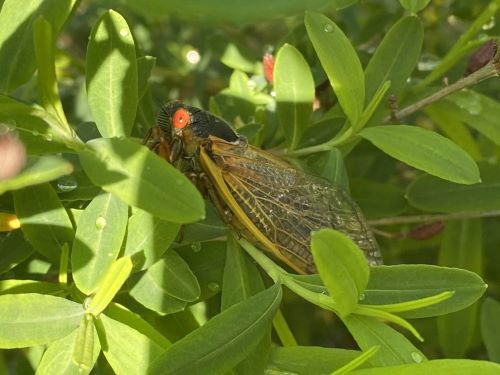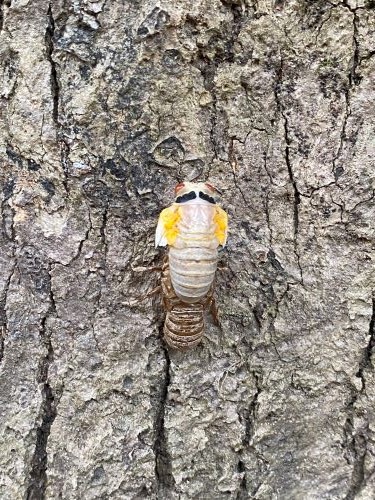Biology lecturer shares "Ode to The Emergence" of the 17-Year Cicada
"My Ode to The Emergence"
By Lauren Spearman, Ph.D., Biology Lecturer
You are in luck. Any day now, billions of cicadas will emerge after 17 years underground and they will congregate with a spectacular crescendo of singing and mating. The moment, when it comes, should remind you that we live in a special place on this planet. Feeding on the liquid nutrients of tree roots since 2004, the last-stage cicada nymphs are just days from emerging from the ground en masse. This 7-minute film Return of the Cicadas beautifully encapsulates their life cycle.
There are 3 species of periodical cicadas in the genus Magicicada that will emerge this year, named collectively “Brood X” (Roman numeral ten). You will most likely have the privilege of meeting Magicicada septendecim, a species described in 1758 by none other than Carl Linnaeus, and yes, this is the same scientist that created the species naming and classification system that we still use today for the diversity of life on Earth.

The periodical cicada life strategy of emerging all at once in the billions has been honed by evolution. Called predator satiation, they simply can’t all be eaten by predators, and those that aren’t eaten will likely survive to reproduce. The cicadas’ buzzing abdomen has purpose in this mission, it generates a love song that can reach 90 decibels, like a lawnmower professing its affection for all to hear! Cicadas sound fierce but are in fact harmless to us; they can’t bite or sting you, so you can put down the bottle of pest killer. Do not panic fellow humans, the cicadas want nothing to do with you, rather male cicadas will use that love song to win that special opportunity to reproduce. It might be a cacophony to you, but it is like a seductive Barry White song to female cicadas (think “My First, My Last, My Everything”). Current research suggests this periodic behavior of Magicicada cicadas (emerging every 13 or 17 years) is around 2.5 million years old, but cicadas themselves, as we recognize them, are about 40 million years old and even deeper fossil evidence suggests cicadas have been singing for up to 200 million years (Sota et al. 2013; Grimaldi and Engle 2005). Sorry Mr. White, the crooning cicadas have you beat. After fertilization, cicada females must drive their eggs into the protective medium of young tree stems to prevent them from being eaten or parasitized. After a few weeks the eggs hatch and the tiny cicada nymphs fall to the ground and they dig in for the long haul. After 17 years of growth underfoot, the entirety of their above-ground life is over in just 4-6 weeks.
 I implore you to not fear their emergence, but instead I invite you to be in awe.
Don’t let others convince you this is a nuisance or frightening. Instead, I invite
you to dive into all the amazing questions we can ask about them. These cicadas remind
us of our greatest evolutionary strengths as humans, our curiosity and imagination.
Cicadas remind us that we are on Earth with other organisms that don’t have the same
timeline or pace of life. Have you thought about how we would look at ourselves differently
if we measured our life in 17-year increments? I wonder what stage of life will you
find yourself in 2038? I think about how my little boys will be men, and frankly I
can ponder only just a moment past that thought because I then wonder for the sake
of my children and all children, what our climate will look like in 2038. And how
will humans treat one another in 2038? Will we look back at 2021 and see it as the
beginning of a new age for humanity?
I implore you to not fear their emergence, but instead I invite you to be in awe.
Don’t let others convince you this is a nuisance or frightening. Instead, I invite
you to dive into all the amazing questions we can ask about them. These cicadas remind
us of our greatest evolutionary strengths as humans, our curiosity and imagination.
Cicadas remind us that we are on Earth with other organisms that don’t have the same
timeline or pace of life. Have you thought about how we would look at ourselves differently
if we measured our life in 17-year increments? I wonder what stage of life will you
find yourself in 2038? I think about how my little boys will be men, and frankly I
can ponder only just a moment past that thought because I then wonder for the sake
of my children and all children, what our climate will look like in 2038. And how
will humans treat one another in 2038? Will we look back at 2021 and see it as the
beginning of a new age for humanity?
Thinking that far ahead can be scary. But, what if… what if we made significant cultural change with regards to our ecological footprints? What if climate change was something humanity, and my own Loyola students today championed like no other generation before them? What if in 2038 my students’ children inherited a planet that was no longer wasting resources, destroying habitats, and pumping greenhouse gasses into the atmosphere? It can happen. Maybe the cicadas’ love song is something deeper. Perhaps it is a primal call to be heard, to care, or to make these moments we have on Earth count. Perhaps it is a call to action. My last question for you is what kind of Earth do you want in 17 years-time when you hear the call of Brood X once more?
Spread the knowledge and excitement!

- Cicadas do not bite or sting! Pesticides are futile against cicadas and harmful to other animals (and us humans). Native wildlife eat these cicadas. Our dogs and cats will likely consume large quantities of these critters too– do we want them consuming pesticides?
- You can be a community scientist! By providing the location where you find the three cicada species, you are helping scientists unravel the many mysteries that still abound about periodical cicada biology. You are also helping provide data to see what impacts a warming world is having on these amazing creatures. There is an App to help you do this! Use the Cicada Safari (https://www.cicadasafari.org) when you spot these emerging wonders.
- Ecology questions abound! Cicadas serve as food for many birds and small mammals. Population biologists will ask how the arrival of this abundance of food impacts the population growth of cicada predators. Community ecologists might ask how the arrival of this abundance of food above ground changes interactions between species. Does it release predatory pressure on other invertebrates above and below ground? Ecosystem ecologists might ask how the death and consumption of these cicadas results nutrients released back into the environment, and how they make their way from the soil to streams.
- Evolution questions abound! Phylogeneticists and evolutionary biologists have proposed two hypotheses regarding the evolution of this incredible 17-year life cycle strategy (Ito 2015). One hypothesis is that it is driven by predation pressure, and that emerging all at once every 13 or 17 years, a high prime number (nod to the mathematicians!) throws off the dance that they have with would-be predators (Tanaka et al. 2009; Koenig and Liebhold 2013). A second hypothesis is that this life strategy first evolved in response to the cyclic climatic cooling of glaciation during the Pleistocene Epoch (Yoshimura 1997). How will climatic changes today alter the evolutionary path of all periodical cicadas? Still curious? Meet Dr. Chris Simon, a pioneer in this world of inquiry who recently shared her thoughts in the Washington Post.
- Conservationists consistently list habitat degradation and loss at the top of the list for all threats to biodiversity. Underneath the umbrella of habitat degradation and loss is climate change, which will likely alter the distribution of these cicadas or perhaps they will not be able adapt fast enough. How much warmer will our climate be 2038? 2055? Multiple other periodical cicada broods have been documented as extinct, and some hypothesize they are victims of climate and habitat changes too great to overcome (Simon et al. 2000). Even the smallest pieces of land, the margins of properties, the soil hemmed in by paving, could do more for wildlife and our own health if we simply planted more native plants. Meet a champion of rewilding our urban and suburban world, Dr. Doug Tallamy.
- Worried about your garden? Cicadas are not a threat to non-woody plants. Females will lay eggs in the smallest woody branches of trees and small woody shrubs (diameter of a pencil to ½ inch). For the most part, these woody plants can handle the natural pruning cicadas provide (“flagging” is when sporadic tips of the canopy crown go dead), but recently planted woody plants might need some extra help and can be protected with garden netting with a ¼-inch or smaller opening (cicadas can’t get through, and birds and other organisms don’t get entangled). Be sure to remove netting as soon as the cicadas are finished for the season. For more questions the University of Maryland Extension can help (https://extension.umd.edu/resource/cicadas).
Other great resources:
- Dr. Mike Raupp and the Cicada Crew at the Department of Entomology, University of Maryland - College Park: https://cicadacrewumd.weebly.com
- Dan Mozgai: https://www.cicadamania.com
Citation:
Grimaldi, D.A. & Engel, M.S. (2005) Evolution of the Insects. Cambridge University Press, Cambridge.